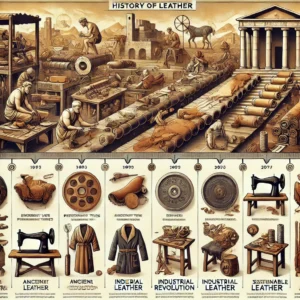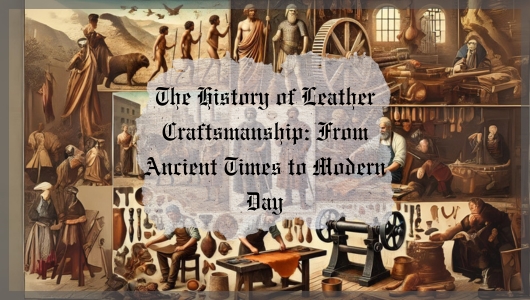The History of Leather Craftsmanship: From Ancient Times to Modern Day

-
Ancient Beginnings
Leather craftsmanship dates back to ancient times, where early humans discovered the unique properties of animal hides. In these early days, the process of leatherworking was basic but essential for survival. Hides were manually scraped to remove flesh and fat, then treated using natural substances like plant extracts and animal fats to preserve and soften the leather. Ancient civilizations, such as the Egyptians, Greeks, and Romans, began to refine these techniques, making leather not only a practical material for clothing and shelter but also for ceremonial and functional purposes. These early practices laid the foundation for more sophisticated leatherworking techniques that would develop over the centuries.
-
The Age of Innovation
As societies evolved, so did their leatherworking techniques. In ancient Rome and Greece, leather craftsmanship reached new heights with advances in tanning processes. The Romans, for example, pioneered the use of tannins from oak and chestnut bark, which improved the durability and flexibility of leather. This era saw leather being used extensively in various aspects of daily life, including footwear, armor, and containers. The Greeks also contributed to the craft, with their leather sandals and protective gear showcasing both functionality and artistry. This period marked a significant evolution in leatherworking, with more refined methods emerging and leather goods becoming integral to both practical and luxury items.
-
Medieval Mastery
The Middle Ages brought about a flourishing of leather craftsmanship in Europe. Leather was a fundamental material in medieval society, used for everything from durable footwear to ornate armor. During this time, guilds and workshops specialized in leatherworking became prominent, standardizing techniques and ensuring high-quality production. The tanning process became more advanced, incorporating new methods such as alum tanning, which produced softer and more pliable leather. This period also saw the rise of leather bookbinding and detailed decorative work, highlighting the artistry and skill involved in medieval leathercraft. The legacy of these advancements continued to influence leatherworking techniques in the centuries that followed.

-
Renaissance and Industrial Revolution
The Renaissance period marked a renaissance in leather craftsmanship, with a renewed emphasis on luxury and artistry. Skilled artisans created exquisite leather goods, from finely detailed footwear to intricately designed accessories. The period also saw significant advancements in tanning and dyeing techniques, allowing for a wider range of colors and finishes. The Industrial Revolution brought about transformative changes, introducing mechanized processes that revolutionized leather production. Innovations such as steam-powered machinery and chemical tanning methods increased efficiency and allowed for mass production. This era marked the beginning of leather as a commodity accessible to a broader audience, setting the stage for modern leather craftsmanship.
-
Modern Craftsmanship
In the 20th and 21st centuries, leather craftsmanship has evolved to incorporate both traditional techniques and modern technologies. Today’s artisans blend time-honored skills with innovations in materials and processes, producing high-quality leather goods that cater to contemporary tastes and standards. There is a growing emphasis on sustainability, with many craftsmen adopting eco-friendly practices and ethical sourcing methods. Modern leatherworking also embraces technological advancements, such as precision cutting and digital design, enhancing both the efficiency and creativity of the craft. This period represents a harmonious blend of heritage and innovation, reflecting the enduring appeal and versatility of leather in the modern world.

Conclusion
The history of leather craftsmanship is a testament to human ingenuity and adaptability. From the rudimentary techniques of ancient civilizations to the sophisticated methods of today, leather has continuously evolved, reflecting both technological advancements and cultural shifts. Each era has contributed to a rich legacy of artistry and functionality, showcasing the material’s versatility and enduring appeal.
In this ongoing tradition, Hakimi Leather proudly carries forward the legacy of leather craftsmanship. By blending traditional techniques with modern innovations, Hakimi Leather not only honors the rich history of leatherworking but also pioneers new standards in ethical and sustainable practices. Our commitment to creating high-quality, eco-friendly leather goods ensures that each product is a tribute to the art and tradition of leathercraft, bridging the past with the future. Through our craftsmanship, we continue to celebrate and preserve the timeless elegance and durability of leather, ensuring that this remarkable material remains as relevant and cherished as ever.





